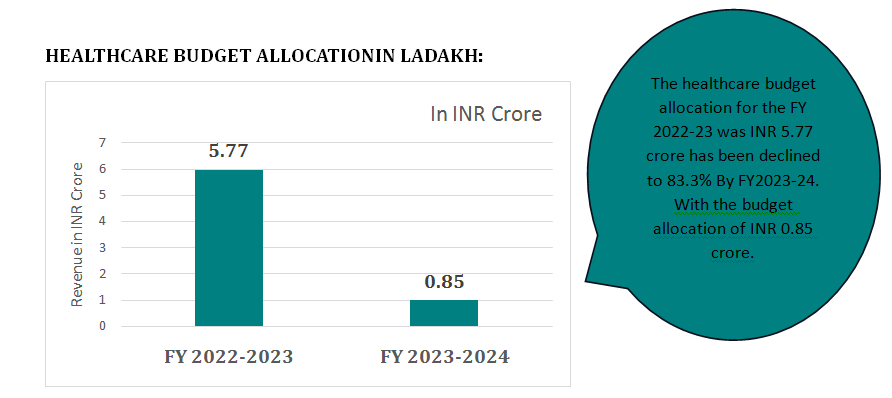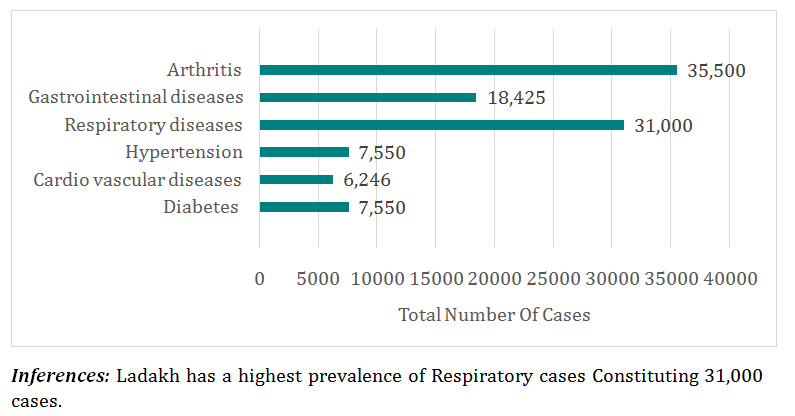Are you currently looking into venturing or investing into the healthcare sector inLadakh? Are you looking for concrete details on the current status of the Healthcare scenario in Ladakh? In this article, Hospaccx Healthcare Consultancy brings to you the latest bits of Information on Ladakhcurrent Healthcare Systems.
INTRODUCTION:
A region located in the northernmost part of India, has been undergoing significant developments and transformations. Ladakh is known for its unique geographical challenges, including high-altitude terrain and extreme weather conditions, which have presented both opportunities and obstacles in the healthcare sector.Traditionally, Ladakh has faced limited access to quality healthcare services due to its remote location and inadequate infrastructure. However, efforts have been made to bridge this gap and improve healthcare facilities in the region. The government of India, along with various healthcare organizations and NGOs, has taken initiatives to address the healthcare needs of the people of Ladakh.
DEMOGRAPHIC PROFILE



HEALTH INDICATORS

Medical Assistance in Ladakh: Improving Healthcare Access
- Oxygen Parlours:are functional from 2023 onwards at the Khardungla top, Gya village on Leh- Manali highway, Tsoltak, Zangla and Abran Health and Wellness Centre in Zanskar area. Oxygen Parlours shall also be set up this year at 3 new tourist routes opened by the Tourism Department Ladakh, which include Phobrang at Martsemik La, Tsog Tsa Lu route, Shyok- Galwan route, and Panamik-Siachen route.
- Traditional Tibetan Medicine: Ladakh is known for its traditional Tibetan medical practices, which incorporate natural remedies, herbal medicines, and holistic healing techniques. Many tourists visit Ladakh seeking alternative treatments and therapies offered by Tibetan medicine practitioners.
- Wellness Retreats: Several wellness retreats and centres have been established in Ladakh, offering yoga, meditation, Ayurveda, and other holistic healing practices. These retreats provide a serene environment and a chance to rejuvenate mind, body, and spirit.
SEVERAL INITIATIVES / SCHEMES WAS IMPLEMENTED
| Name of Scheme | Features & Benefits |
| Janani Suraksha Yojana | · Launch Year :2005
· Beneficiaries: poor pregnant women · Financial Coverage: which integrates cash assistance with delivery and post-delivery care. The Yojana has identified Accredited Social Health Activist (ASHA) as an effective link between the government and pregnant women. |
| Janani Shishu Suraksha Karyakram | · Launch Year: 2011
· Beneficiaries: The initiative entitles all pregnant women delivering in public health institutions to absolutely free and no expense delivery, including caesarean section. · The entitlements include free drugs and consumables, free diet up to 3 days during normal delivery and up to 7 days for C-section, free diagnostics, and free blood wherever required. This initiative also provides for free transport from home to institution, between facilities in case of a referral and drop back home. |
| Universal Health Insurance Scheme (UHIS) Eligibility Criteria: | · Launched Year: 2003
· Beneficiaries: People who fall under the category of Below Poverty Line (BPL) or the Above Poverty Line (APL) are eligible to get health insurance under UHIS.
|
DISEASE BURDEN IN LADAKH:

LIST OF MAJORHOSPITALS IN LADAKH:
- SNM Hospital (Sonam Norbu Memorial Hospital),Leh: Located in Leh, it is a government hospital that provides medical services to the region with 150 beds.
- Mahabodhi Karuna Charitable hospital: The hospitalwas established in 1991, hospital is spread over 200 acres of descent land with 42 beds, 15 ventilator beds and 5 ICU beds.
- Stanzin Healthcare, Leh: A private healthcare facility in Leh, providing various medical services and treatments.
- Nubra Hospital, located in the Nubra Valley region of Ladakh: It serves as a hospital catering to the healthcare needs of the local population.
- Army Hospital, Leh: A military hospital providing medical care primarily to military personnel and their dependents.
- Sub District Hospital, Nubra region of Ladakh: It serves as a hospital catering to the healthcare needs of the local population with 50 beds and was constructed at a cost of 12.78 crore.
UPCOMING MEDICAL FACILITY IN LADAKH :
Spituk Pharka’s medical school a 30-bed hospital located in Tangste. A 100-student medical college with staff housing and a dorm for students are all part of the proposal for Spituk Pharkha. The medical college will have an academic block, lecture theatres, an anatomy department, a dissection hall, a museum, laboratories, student common rooms, medical education units, histology labs, biochemistry labs, pathology labs, cafeterias, libraries, boys’ and girls’ hostels, staff residences, sports and recreation facilities, etc. The total built-up area will be 71000 sqm. Future expansion will also be allowed for, with a 325-crore approved medical college.
HEALTHCARE INVESTMENT OPPORTUNITIES INLADAKH:
- Growing population:
The population of Ladakh for the year 2023 is 3.01 lakh and is estimated to project 3.6 lakhs by the year 2030 with annual growth rate of 13.8%
- Gap in medical infrastructure:
- The total number of available beds, including both government and private sectors are very less. According to the norms, there should be 5 beds per 1,000 population. Hence, there is a need for morebeds, indicating a gap and growth in the healthcare infrastructure.
- Currently there are 7 diagnostic centres inLadakh. As per the norms there should be 1 diagnostic centre per 10,000 population. Therefore, there is a requirement of 30 diagnostic centre indicating a gap of 23 diagnostic centre.
- Government assistance in healthcare investment:
a.Financial Incentives:
- Provision of Startup Monthly Allowance up to INR 15,000 per month for a year to DPIIT recognized startups.
- Monthly Allowance of INR 20,000 per month for a year to startups with Founder/Cofounder as Women/Transgender or SC/ST/SEBC/PH.
- Provision of up to INR 3 Lakh for DPIIT recognized startups operating in Ladakh at Minimum Viable Product (MVP) stage.
- Provision of Marketing Expenses up to a limit of INR 3 Lakh.
- Provision of free incubation or co-working support of up to INR 1 Lakh per year. Provision of 50% patent cost reimbursement for startups up to INR 5 Lakh.
- 100% subsidy on purchase & installation of Green Energy Solutions such as Solar/Wind Generator, Hybrid Solar Wind System to recognized startups in Ladakh.
b.Capacity Development:
- Dedicated fund with budget of INR 10 Lakh to conduct 20 mentorship workshops per year.
c.Prime Minister’s Employment Generation Programme (PMEGP):
- Nature of financial assistance: The rate of Margin Money Subsidy/Govt. Subsidy on the financial assistance is 25% for Urban area and 35% for Rural area with 5% own contribution for Reserved category and 10% of General category.
CONCLUSION
The healthcare scenario in Ladakh has shown significant progress and development in recent years. Despite the unique geographical challenges and extreme weather conditions, efforts have been made to improve healthcare infrastructure and delivery systems in the region. The government of India, along with healthcare organizations and NGOs, has taken initiatives to bridge the gap in access to quality healthcare services. The growing population of Ladakh demands an increase in healthcare infrastructure, including beds and diagnostic centres. There is a need for government assistance and investment in healthcare to address these gaps and support the development of the sector.
Above is the superficial and macro level study for in-depth market and financial feasibility studies or any other healthcare-related research needs, please feel free to reach out to us at +91-8655170700 or email us at hospaccx.india@gmail.com. Our team is equipped to provide comprehensive and detailed insights tailored to your specific requirements.

